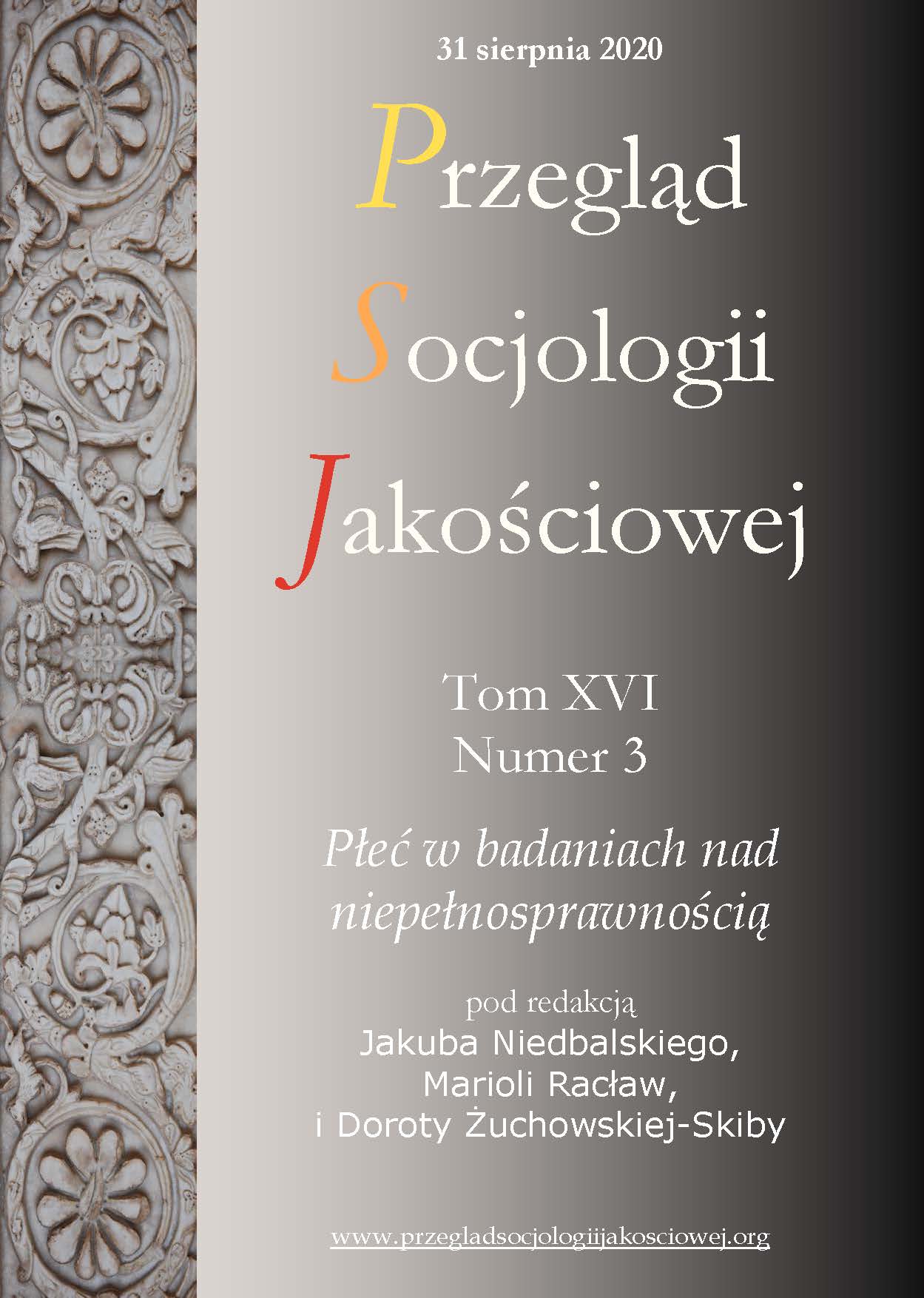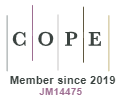Hybrydowe tożsamości? Trajektorie życia kobiet z niepełnosprawnościami nabytymi
DOI:
https://doi.org/10.18778/1733-8069.16.3.05Słowa kluczowe:
tożsamość, kobiety z niepełnosprawnością, niepełnosprawność nabyta, niepełnosprawność ruchu, punkt zwrotnyAbstrakt
W badaniu nad niepełnosprawnością niezwykle istotną rolę odgrywają kwestie związane z przemianami tożsamości dokonującymi się pod wpływem doświadczeń, które zmieniają dotychczasowy bieg życia i wymuszają przyjęcie nowych ról i adaptację dotychczas wypełnianych. Taki charakter ma niepełnosprawność nabyta w dorosłym życiu. Stanowi ona punkt zwrotny powodujący transformację tożsamości kobiet, które muszą na nowo zdefiniować siebie i swoje miejsce w nowej dla nich rzeczywistości. Zasadniczym celem artykułu będzie ukazanie przemian, jakim podlegają tożsamości kobiet, które w wyniku wypadku nabyły niepełnosprawność w wieku dorosłym. Badania oparto o autobiograficzne wywiady narracyjne. Metoda ta pozwoliła na odtworzenie trajektorii życia respondentek, ukazując procesualny charakter kształtowanych przez nie tożsamości, które ulegały zmianom pod wpływem konieczności dopasowania się do warunków wynikających z nabytej niepełnosprawności. Badaniu poddano 6 kobiet zróżnicowanych pod kątem wieku, wykształcenia, pozycji zawodowej oraz sytuacji rodzinnej, które wpływały na realizowane przez nie role i zajmowane pozycje społeczne.
Pobrania
Bibliografia
Asch, Adrienne and Michelle Fine Michelle. 1988. “Introduction: Beyond pedestals.” Pp 1-37. in Women with disabilities: Essays in psychology, culture, and politics, edited by A. Asch and M. Fine. Philadelphia, PA: Temple University Press.
Google Scholar
Asch, Adrienne and Michelle Fine. 1997. “Sexuality and Women with Disabilities: The Example of Women and Literature.” Pp. 241-255 in Disability Studies Reader, edited by L. Davis. New York, London: Routledge.
Google Scholar
Barnes, Coli and Geof Mecer. 2008. Niepełnosprawność. Warsaw: Sic!
Google Scholar
Barnwell, Alice M. and David J. Kavanagh. 1997. “Prediction of psychological adjustment to multiple sclerosis.” Social Science and Medicine 45:411-418.
Google Scholar
DOI: https://doi.org/10.1016/S0277-9536(96)00356-5
Beckwith, Alison, and Matthew Kwai-Sang Yau. 2013. “Sexual recovery: Experiences of women with Spinal injury reconstructing a positive sexual identity.” Sexuality and Disability 31:313-324.
Google Scholar
DOI: https://doi.org/10.1007/s11195-013-9315-7
Begum, Nasa. 1992. “Disabled Women and the Feminist Agenda.” Feminist Review 1(40):70-84.
Google Scholar
DOI: https://doi.org/10.1057/fr.1992.6
Brooks, Nancy and Mary Jo Deegan. 1981. “Women and Disability: The Double Handicap.” The Journal of Sociology and Social Welfare 2(8):229-231.
Google Scholar
Brooks, Nancy A., and Ronald R. Matson. 1982. “Social-psychological adjustment to multiple sclerosis: A longitudinal study.” Social Science and Medicine 16(24): 2129-2135.
Google Scholar
DOI: https://doi.org/10.1016/0277-9536(82)90262-3
Burke, Peter. 2009. Cultural hybridity. Cambridge: Polity Press.
Google Scholar
Campbell, Fiona K. 2009. Contours of Ableism: Territories, Objects, Disability and Desire. London: Palgrave Macmillan.
Google Scholar
DOI: https://doi.org/10.1057/9780230245181
Carr, David. 1986. Time, narrative and history. Bloomington, IN: Indiana University Press.
Google Scholar
Charmaz, Kathy. 1995. “The body, identity, and self: Adapting to impairment.” The Sociological Quarterly 36(4):657-680.
Google Scholar
DOI: https://doi.org/10.1111/j.1533-8525.1995.tb00459.x
Ciaputa, Ewelin, Agnieszka Król, and Marta Warat. 2014. “Genderowy wymiar niepełnosprawności. Sytuacja kobiet z niepełnosprawnościami wzroku, ruchu i słuchu.” Pp. 153-174 in Polscy niepełnosprawni: od kompleksowej diagnozy do nowego modelu polityki społecznej, edited by B. Gąciarz and S. Rudnicki. Cracow: Wydawnictwo AGH.
Google Scholar
Ciaputa, Ewelina et al. 2014. “Macierzyństwo kobiet z niepełnosprawnościami ruchu, wzroku i słuchu.” Studia Socjologiczne 2(213):203-224.
Google Scholar
Craig, Ashley R., Karen Hancock, and Esther Chang. 1994. “The influence of spinal cord injury on coping styles and self-perceptions two years after the injury.” Australian and New Zealand Journal of Psychiatry 2(28):307-312.
Google Scholar
DOI: https://doi.org/10.1080/00048679409075644
Deaux, Kay (1993) “Reconstructing social identity.” Personality and Social Psychology Bulletin 19(1):4-12.
Google Scholar
DOI: https://doi.org/10.1177/0146167293191001
Deaux, Kay. 2001. “Social identity.” Pp. 1059-1068 in Encyclopedia of women and gender, edited by J. Worrell. San Diego, CA: Academic Press.
Google Scholar
Deegan, Mary Jo. 2018. Women and disability: The double handicap. New York: Routledge.
Google Scholar
DOI: https://doi.org/10.4324/9781351318082-1
Dolch, Norman A. 2003. “Role.” Pp. 391-410 in Handbook of Symbolic Interactionism, edited by L. T. Reynolds and N. J. Herman-Kinney. Walnut Creek: Alta Mira Press.
Google Scholar
Ethier, Kathleen A. and Kay Deaux. 1994. “Negotiating social identity when contexts change: Maintaining identification and responding to threat.” Journal of Personality and Social Psychology 2(67):243-251.
Google Scholar
DOI: https://doi.org/10.1037/0022-3514.67.2.243
Ferri, Beth A. and Noel Gregg. 1998. “Women with disabilities: Missing voices.” Women’s Studies International Forum 4(21):429-439.
Google Scholar
DOI: https://doi.org/10.1016/S0277-5395(98)00038-7
Finger, Ann. 1991. Past Due: A Story of Disability, Pregnancy and Birth. Seattle: Seal Press.
Google Scholar
Finger, Ann. 1992. “Forbidden Fruit.” New Internationalist 233:8-10.
Google Scholar
Forber-Pratt Anjali J. et al. 2017. “Disability identity development: A systematic review of the literature.” Rehabilitation Psychology 62:198-207.
Google Scholar
DOI: https://doi.org/10.1037/rep0000134
Frank, Ann W. 1993. “The rhetoric of self-change: illness experience as narrative.” The Sociological Quarterly 1(34):39-52.
Google Scholar
DOI: https://doi.org/10.1111/j.1533-8525.1993.tb00129.x
Goethals, Tina, Elisabeth De Schauwer, and Geert Van Hove. 2015. “Weaving Intersectionality into Disability Studies Research: Inclusion, Reflexivity and Anti-essentialism.” Journal for Diversity and Gender Studies 2(1-2):75-94.
Google Scholar
DOI: https://doi.org/10.11116/jdivegendstud.2.1-2.0075
Gonçalves, Kellie. 2013. “‘Cooking lunch, that’s Swiss’: Constructing hybrid identities based on socio-cultural practices.” Multilingua 4(432):527-547.
Google Scholar
DOI: https://doi.org/10.1515/multi-2013-0026
Goodley, Dan. 2011. Disability Studies. An Interdisciplinary Introduction. London: Sage.
Google Scholar
Hancock. Marie A. 2007. “When Multiplication Doesn’t Equal Quick Addition: Examining Intersectionality as a Research Paradigm.” Perspectives on Politics 1(5):63-79.
Google Scholar
DOI: https://doi.org/10.1017/S1537592707070065
Hermanns, Harry. 1987. “Narrative interview – a new tool for sociological field research.” Acta Universitatis Lodziensis: Folia Sociologica 13:43-56.
Google Scholar
Hormuth, Stefan E. 1990. The ecology of the self: Relocation and self-concept change. Cambridge: Cambridge University Press.
Google Scholar
Hughes Rosemary B. et al. 2003. “Health promotion for women with physical disabilities: A pilot study.” Rehabilitation Psychology 3(48):182-188.
Google Scholar
DOI: https://doi.org/10.1037/0090-5550.48.3.182
Jenkins, Richard. 2005. Social Identity. London, New York: Routledge.
Google Scholar
Konecki, Krzysztof T. 2015. “Anselm L. Strauss—Pragmatic Roots, Pragmatic Implications.” Przegląd Socjologii Jakościowej 1(11):12-39.
Google Scholar
DOI: https://doi.org/10.18778/1733-8069.11.1.02
Król, Agnieszka. 2018. “Niepełnosprawność i sprawiedliwość reprodukcyjna. Zarys wybranych zagadnień dotyczących kobiet z niepełnosprawnościami.” Annales Universitatis Paedagogicae Cracoviensis. Studia de Cultura 1(10):84-99.
Google Scholar
DOI: https://doi.org/10.24917/20837275.10.1.7
Kubicki, Paweł. 2017. Polityka publiczna wobec osób z niepełnosprawnościami. Warsaw: Oficyna Wydawnicza SGH Szkoła Główna Handlowa w Warszawie.
Google Scholar
Kumaniecka-Wiśniewska, Agnieszka. 2006. Kim jestem? Tożsamość kobiet upośledzonych umysłowo. Warsaw: Wydawnictwo Akademickie.
Google Scholar
McDonald, Katherine E., Christofer Keys, and Fabricio E. Balcazar. 2007. “Disability, race/ethnicity and gender: themes of cultural oppression, acts of individual resistance.” American Journal of Community Psychology 39(1-2):145-161.
Google Scholar
DOI: https://doi.org/10.1007/s10464-007-9094-3
Milligan, Maureen S. and Alfred H. Neufeldt. 2001. “The myth of asexuality: A survey of social and empirical evidence.” Sexuality and Disability” 19(2):91-109.
Google Scholar
DOI: https://doi.org/10.1023/A:1010621705591
Moin, Victor, Ilana Duvdevany, and Daniela Mazor. 2009. “Sexual Identity, Body Image and Life Satisfaction Among Women With and Without Physical Disability.” Sexuality Disability 27:83-95.
Google Scholar
DOI: https://doi.org/10.1007/s11195-009-9112-5
Morris, Jenny. 1993. “Feminism and Disability.” Feminist Review 1(43):57-70.
Google Scholar
DOI: https://doi.org/10.1057/fr.1993.4
Moser, Ingunn. 2006. “Sociotechnical practices and difference: On the interferences between disability, gender, and class.” Science, Technology and Human Values 31(5):537-564.
Google Scholar
DOI: https://doi.org/10.1177/0162243906289611
Nosek, Margaret A. 1996. “Wellness among women with physical disabilities.” Pp. 17-33 in Women with physical disabilities: Achieving and maintaining health and well-being, edited by D. M. Krotoski, M. A. Nosek, and M. A. Turk. Baltimore: Brookes.
Google Scholar
Nosek, Margaret A. and Rosemary B. Hughes. 2003. “Psychosocial Issues of Women with Physical Disabilities: The Continuing Gender Debate.” Rehabilitation Counseling Bulletin 4(46):224-233.
Google Scholar
DOI: https://doi.org/10.1177/003435520304600403
Nosek, Margaret A. et al. 2003. “Self-esteem and women with disabilities.” Social Science and Medicine 56:1737-1747.
Google Scholar
DOI: https://doi.org/10.1016/S0277-9536(02)00169-7
Oyserman, Dafna. 2004. “Self-concept and identity.” Pp. 5-24 in Self and Social Identity, edited by M. B. Brewer and M. Hewstone: Hoboken: Blackwell Publishing.
Google Scholar
Piątek, Katarzyna. 2009. “Kilka uwag o trudnościach badawczych problemu niepełnosprawności – na przykładzie kobiet z niepełnosprawnością fizyczną.” Pp. 217-224 in Metody, techniki i praktyka badań społecznych, edited by A. Bąk and Ł. Kubisz-Muła. Bielsko-Biała: Wydawnictwo Akademii Techniczno-Humanistycznej.
Google Scholar
Riemann, Gerhard and Fritz Schütze. 1992. „‘Trajektoria’ jako podstawowa koncepcja teoretyczna w analizach cierpienia i bezładnych procesów.” Kultura i Społeczeństwo 2(36):89-108.
Google Scholar
Simon, Bernd. 2004. Identity in modern society: A social psychological perspective. Hoboken: Blackwell Publishing.
Google Scholar
Stojkow, Maria and Dorota Żuchowska-Skiba. 2018. “Hybrid identities? Trajectories of the fate of old Muslim women in Poland.” Revista Prisma Social 21:177-193.
Google Scholar
Strauss, Anselm L. 1959. Mirrors and masks. The search for identity. Chicago: University of Chicago Press.
Google Scholar
Strauss, Anselm L. 1995. “Identity, Biography, History, and Symbolic Representations.” Social Psychology Quarterly 1(58):4-12.
Google Scholar
DOI: https://doi.org/10.2307/2787139
Strauss, Anselm L. 2013. Zwierciadła i maski. W poszukiwaniu tożsamości. Kraków: Nomos.
Google Scholar
Szczęsna, Ewa. 2004. “Tożsamość hybrydyczna.” ER(R)GO 2(9):9-18.
Google Scholar
Taleporos, George and Mariat McCabe. 2002. “The impact of sexual esteem, body esteem, and sexual satisfaction on psychological well-being in people with physical disability.” Sexuality and Disability 20(3):177-183.
Google Scholar
DOI: https://doi.org/10.1023/A:1021493615456
Thomas, Carol. 1997. “The Baby and the Bath Water: Disabled Women and Motherhood in Social Context.” Sociology of Health and Illness 5(19):622-643.
Google Scholar
DOI: https://doi.org/10.1111/1467-9566.00073
Thomas, Carol. 1999. Female Forms: Experiencing and Understanding Disability. Buckingham: Open University Press.
Google Scholar
Tøssebro, Jan. 2004. “Understanding disability: introduction to the special issues of SJDR.” Scandinavian Journal of Disability Research 6(1):3-7.
Google Scholar
DOI: https://doi.org/10.1080/15017410409512635
Walsh, Anthony and Patricia Ann Walsh. 1989. “Love, self-esteem, and multiple sclerosis.” Social Science and Medicine 7(29):793-798.
Google Scholar
DOI: https://doi.org/10.1016/0277-9536(89)90078-6
Wendelborg, Christian and Jan Tøssebro. 2010. “Marginalisation processes in inclusive education in Norway: a longitudinal study of classroom participation.” Disability & Society 6(25):701-714.
Google Scholar
DOI: https://doi.org/10.1080/09687599.2010.505744
Wołowicz-Ruszkowska, Agnieszka. 2013. Zanikanie? Trajektorie tożsamości kobiet z niepełnosprawnością. Warsaw: Wydawnictwo APS.
Google Scholar
Pobrania
Opublikowane
Jak cytować
Numer
Dział
Licencja

Utwór dostępny jest na licencji Creative Commons Uznanie autorstwa – Użycie niekomercyjne – Bez utworów zależnych 4.0 Międzynarodowe.














